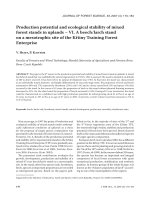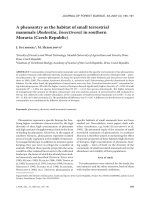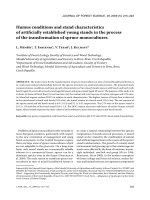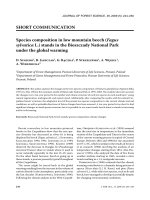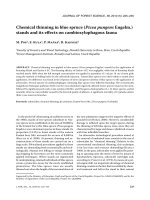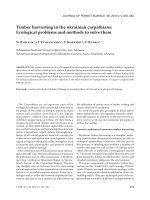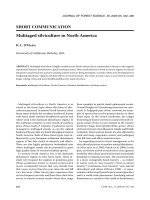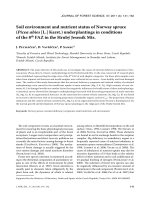Báo cáo lâm nghiệp: "Experimental control in Weigela japonica of flower initiatiob" ppt
Bạn đang xem bản rút gọn của tài liệu. Xem và tải ngay bản đầy đủ của tài liệu tại đây (126.09 KB, 3 trang )
Experimental
control
of
flower
initiation
in
Weigela
japonica
M. Bodson
Centre
de
Physiologie
Vegetale
Appliqu6e
(IRSIA),
Universite
de
Liege,
Institut
de
Botanique,
B22,
Sart
Tilman,
B-4000
Li6ge,
Belgium
Introduction
Most
of
the
experimental
work
on
the
mechanisms
controlling
flowering
are
reported
for
herbaceous
annuals
for
which
floral
transition
is
under
photoperiodic
control.
Experimentation
with
these
spe-
cies
has
emphasized
the
importance
of
the
leaf
system
for
the
perception
of
the
proper
photoperiod
and
made
clear
that
the
leaf
processes
resulting
in
the
synthe-
sis
of
the
flowering
stimulus
are
a
major
control
point
of
the
floral
transition
(Zee-
vaart,
1976;
Bernier,
1988).
Several
characteristics
are
specific
to
the
floral
transition
of
woody
perennials.
For
most
woody
species
of
the
temperate
zone:
1)
flowers
are
initiated
on
resting
axillary
buds;
2)
there
is
a
long
rest
period
between
flower
initiation
and
anthesis;
3)
there
is
no
direct
control
of
flower
initia-
tion
by
the
daylength,
while
vegetative
growth
may
be
under
strong
photoperiodic
control
(Nitsch,
1957);
and
4)
the
floral
response
is
localized
to
certain
buds
(Jackson
and
Sweet,
1972;
Buban
and
Faust,
1982).
The
causes
of
this
localiza-
tion
of
the
floral
response
are
still
largely
unknown
and
may
be
related
to
physio-
logical
conditions
internal
to
the
bud
(Romberger,
1963;
Crabbe,
1984).
One
may
thus
suspect
that
the
floral
transition
of
woody
species
is
controlled
by
specific
mechanisms
not
found
in
photoperiodic
annuals.
A
study
has
been
started with
Weigela
japonica,
a
woody
ornamental,
to
consider
some
aspects
of
this
question.
Results
are
reported
on
the
effect
of
a
pruning
treatment
on
the
floral
response
of
resting
axillary
buds.
Two
points
were
investigated:
1)
the
floral
response
with
regard
to
the
age
of
the
buds
located
at
a
similar
node
position;
and
2)
the
floral
re-
sponse
at
a
single
time
of
pruning
applied
at
different
node
positions
on
the
same
axis.
Materials
and
Methods
Plants
were
propagated
by
cuttings.
The
rooted
cuttings
were
first
potted
in
leaf
mould
in
7-cm
clay
pots.
After
3
wk,
they
were
transplanted
into
peat
moss
(TKS
2,
Oldenburg,
Germany)
and
pinched
so as
to
keep
2
leaf
pairs
and
their
respective
axillary
buds.
Such
a
plant
will
de-
velop
4
axillary
shoots.
The
zero
time
was
arbitrarly
fixed
at
the
time
of
pinching.
The
plants
were
kept
in
16-h
LD,
under
fluorescent
tubes
(cool
white,
4300°K,
ACEC,
Charleroi,
Belgium),
at
a
constant
temperature
of
20°C
and
relative
humidity
of
60%.
The
light
flux
at
the
top
of
the
canopy
was
250
¡lEom-
2
os-
1.
Under
these
conditions,
all
the
axillary
buds
from
intact
plants
remained
vegetative
for
up
to
150
d.
Results
reported
here
concern
only
those
buds
located
at
the
node
just
below
the
pruning
zone.
Results
In
the
first
experiment,
ramifications
of
dif-
ferent
ages
were
pruned
so
as
to
keep
3
nodes.
For
an
early
pruning,
realized
after
40
d
of
growth,
all
buds
developed
as
leafy
shoots
(Table
I).
When
90-d
old
rami-
fications
were
pruned,
80%
of
the
buds
developed
as
reproductive
axes
and
the
floral
response
decreased
for
later
pruning
times.
In
the
second
experiment,
the
pruning
treatments
were
applied
to
90-d
old
shoots
and
carried
out
so
as
to
keep
a
variable
number
of
nodes
(from
1
to
4).
The
type
of
development
of
the
axillary
buds
depended
upon
their
position
on
the
shoot
(Table
II).
The
buds
located
at
the
base
of
the
ramification
developed
essen-
tially
as
leafy
shoots
and
the
percentage
of
buds
developing
as
reproductive
axes
increased
with
the
position
of
the
buds.
The
optimum
was
observed
for
buds
lo-
cated
at
the
axil
of
node
3.
Conclusions
These
results
show
that:
1)
at
a
specific
time,
all
the
axillary
buds
located
along
the
ramification
did
not
have
a
similar
capacity
to
initiate
flowers
in
response
to
a
pruning
treatment;
and
2)
there
was
an
optimal
timing
for
buds
at
a
specific
location
on
the
ramification
to
respond
to
a
treatment
promoting
flowering.
These
observations
suggest
that
the
control
of
flowering
is
at
least
partially
located
within
the
bud.
This
control
could
be
related
to
morphological
or
biochemical
properties
of
certain
com-
ponents
of
the
bud
specific
to
its
physio-
logical
age
and/or
linked
to
the
relation
of
the
bud
to
the
other
growth
centers
of
the
plant.
An
anatomical
description
of
the
bud
with
regard
to
its
organogenetic
activity
is
presently
under
investigation
to
detect
and
localize
within
the
bud
the
histological
modifications
specifically
involved
in
the
floral
transition.
References
Bernier
G.
(1988)
The
control
of
floral
evocation
and
morphogenesis.
Annu.
Rev.
Plant
Physiol.
39. 175-219
9
Buban
T.
&
Faust M.
(1982)
Flower
bud
induc-
tion
in
apple
trees:
internal
control
and
differen-
tiation.
Hortic.
Rev.
4,
174-203
Crabbe
J.J.
(1984)
Vegetative
vigor
control
over
location
and
fate
of
flower
buds
in
fruit
trees.
Acta Hortic.
149, 55-63
Jackson
D.J.
&
Sweet
G.B.
(1972)
Flower
initia-
tion
in
temperate
woody
plants.
Hortic.
Abstr.
42, 9-24
Nitsch
J.P.
(1957)
Photoperiodism
in
woody
plants.
Proc.
Am.
Soc.
Hortic.
Sci.
70,
526-544
Romberger
J.A.
(1963)
Meristems,
growth
and
development
in
woody
plants.
US
Department
of
Agriculture,
Tec:hnical
Bull.
no.
1293,
pp.
214
4
Zeevaart
J.A.D.
(1976)
Physiology
of flower
for-
mation.
Annu.
Rev.
Plant
Physiol.
27,
321-348


